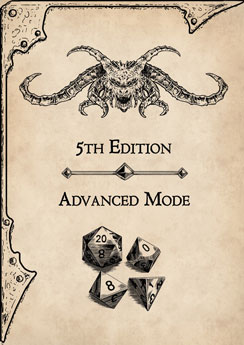Large beast (dinosaur), unaligned
Armor Class 16 (natural armor
Hit Points 84 (8d10 + 40)
Speed 40 ft.
Proficiency Bonus +3
Proficiency Bonus +4 (5th Edition Advanced Mode)
| STR | DEX | CON | INT | WIS | CHA |
|---|---|---|---|---|---|
| 22 (+6) | 14 (+2) | 20 (+5) | 1 (-5) | 10 (+0) | 6 (-2) |
Saving Throws Str +9, Con +8
Skills Perception +4
Senses passive Perception 13
Languages –
Challenge 5 (1,800 XP)
Pack Tactics. The ceratosaurus has advantage on an attack roll against a creature if at least one of the ceratosaurus’s allies is within 5 feet of the creature and the ally isn’t incapacitated.
ACTIONS
- Multiattack. The ceratosaurus makes four attacks: two with its claws, one with its bite, and one attack with its horn.
- Bite. Melee Weapon Attack: +9 to hit, reach 10 ft., one target. Hit: 20 (4d6 + 6) piercing damage.
- Claws. Melee Weapon Attack: +9 to hit, reach 5 ft., one target. Hit: 9 (1d6 + 6) slashing damage.
- Horn. Melee Weapon Attack: +9 to hit, reach 5 ft., one target. Hit: 19 (3d8 + 6) piercing damage.
5th Edition Advanced Mode
Limiting the power of a character and making the overall difficulty of the game harder, does not reduce the creativity, indeed it does quite the opposite.
The Game Master has the option to use any and all of the instances proposed in this guide, or just some of them according to their preference.
It is the lack of something that move and motivate characters, not the abundance of it
DESCRIPTION
The ceratosaurus is a medium-sized theropod dinosaur that belongs to the ceratosauridae family. It has a distinctive horn on its nose, which is actually a fusion of two nasal bones. The horn is probably used for display and intimidation, rather than for fighting. The ceratosaurus also has a large brain and a prominent crest on its skull, which may be involved in communication or social behavior.
The ceratosaurus has a long and slender neck, which allows it to reach high branches and prey on animals like small mammals or birds. It also has powerful jaws with sharp teeth that can crush bones and tear flesh. The ceratosaurus has four fingers on each hand, but they are reduced to small claws. It has long and muscular legs with three toes on each foot, which are adapted for running and jumping.
COMBAT
The ceratosaurus is not a very aggressive or territorial dinosaur. It prefers to avoid confrontation with other predators or rivals, unless it feels threatened or hungry. It relies on its speed and agility to escape from danger or ambush its prey. It also uses its horn as a weapon or a tool to defend itself or to break open hard objects.
The ceratosaurus may hunt in packs with other members of its species or family group. This could help it to cooperate in finding food or to protect each other from attacks. However, there is not enough evidence to confirm this hypothesis.
HABITAT / SOCIETY
The ceratosaurus lives in various habitats during its lifetime, ranging from semi-arid plains and forests to swamps and rivers. It may be able to adapt to different environments by changing its diet or behavior accordingly.
The ceratosaurus is probably a solitary animal that does not form strong social bonds with other members of its species or family group. However, it may communicate with vocalizations or body language with other ceratosaurids that live nearby.
ECOLOGY
The ceratosaurus is an omnivorous dinosaur that eats both plants and animals. It may feed on fruits, seeds, nuts, leaves, flowers, insects, worms, snails, frogs, fish, birds, reptiles, amphibians, mammals, eggs, carrion, or anything else that it can find or catch.
